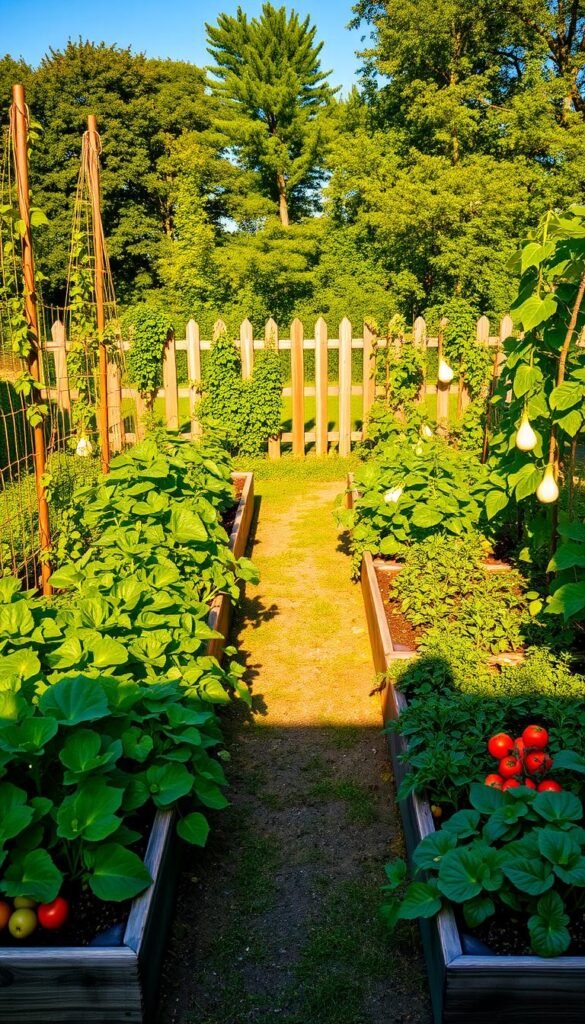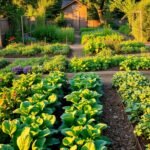Ever wondered how to turn that sunny corner of your yard into a flourishing edible oasis? Whether you’re working with a sprawling backyard or a compact balcony, smart planning can transform even the most unlikely spots into vibrant growing areas. The secret? It’s not about rigid formulas—it’s about adapting ideas to fit your lifestyle and environment.
Gardening expert Steven Biggs reminds us there’s no single “right” way to arrange plants. Two people could approach the same patch of soil and create entirely different yet equally successful setups. That’s because your plot should reflect what you want to grow, how much time you have, and what makes you smile when you step outside.
This guide focuses on practical strategies that work for raised beds, containers, or traditional rows. You’ll learn how to position crops for better sunlight access, manage pathways efficiently, and pair plants that thrive together. But here’s the twist: we’ll show you when to follow the rules—and when to trust your gut.
Forget chasing perfection. Your goal is to create a space that feels joyful to tend and delivers fresh flavors to your table. Ready to dig into the possibilities?
Understanding Your Garden Space and Its Unique Challenges
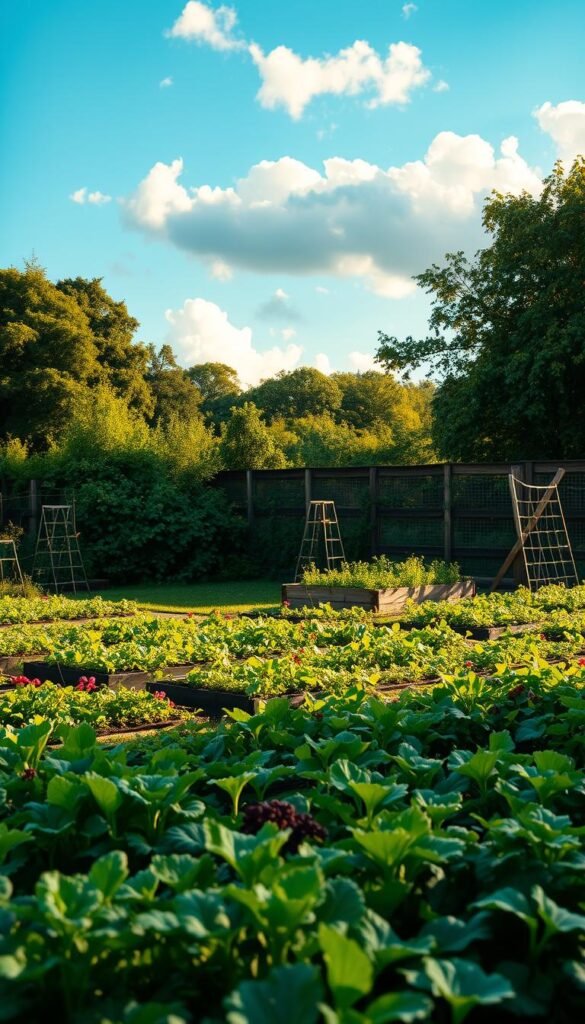
Did you know that the secret to thriving plants starts with observing your land’s hidden patterns? Before planting a single seed, become a detective in your own backyard. Watch how sunlight shifts across your plot and notice where water pools after rain—these clues shape your strategy.
“Map sunlight patterns through seasons—morning sun with afternoon shade often gives plants the perfect balance,” advises gardening expert Angela Judd. She also recommends “designing with water flow” using swales or rain barrels during storms.
Assessing Available Area and Soil Conditions
Start by measuring your growing space. Even small areas can surprise you! Test your soil’s drainage by digging a 12-inch hole and filling it with water. If it drains in 1-3 hours, you’ve got ideal conditions. Clay-heavy earth? Mix in compost to improve texture.
| Sunlight Zone | Hours of Light | Best Plant Matches |
|---|---|---|
| Full Sun | 6-8 hours | Tomatoes, peppers |
| Partial Shade | 3-6 hours | Lettuce, spinach |
| Deep Shade | Hostas, ferns |
Recognizing Sunlight, Shade, and Microclimates
Your neighbor’s fence or that mature oak tree creates microclimates—pockets with unique growing conditions. Track shadows at 9 AM, noon, and 3 PM for three days. You’ll spot patterns that help position heat-loving crops versus shade-tolerant greens.
Slopes and wind patterns matter too. North-facing areas stay cooler, while south-facing spots bake. Use these quirks to your advantage—plant mint where runoff occurs or blueberries in acidic soil patches. Your challenges become opportunities!
Planning a Productive Layout That Maximizes Your Garden’s Potential
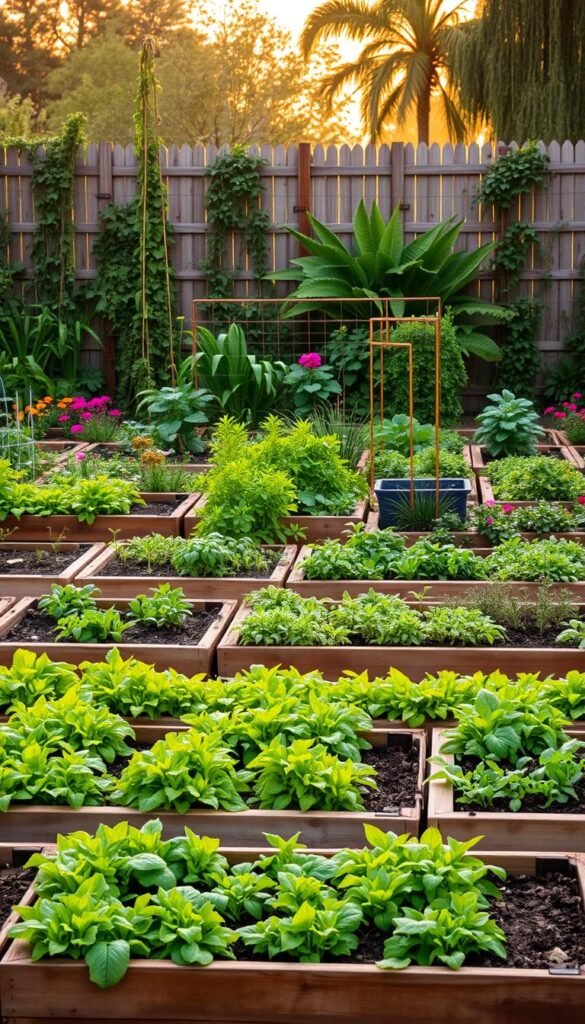
What if every square foot of your growing area could work smarter, not harder? Strategic placement of raised beds and containers turns tricky spaces into productive zones. Focus on sun patterns first—track where morning light hits longest for heat-loving crops.
Identifying the Best Spots for Raised Beds and Containers
Position taller raised beds where they won’t cast shadows on shorter plants. Sloped yard? Terrace beds across the incline to prevent soil erosion. For containers, choose mobile options like rolling planters. Rotate them seasonally to chase sunlight.
Drainage matters most. Elevate beds 6-12 inches in soggy areas using gravel bases. Urban spaces? Try vertical stackable planters against south-facing walls. They’ll capture warmth while saving floor space.
Using Pathways Efficiently to Preserve Growing Area
Steven Biggs’ dead-end pathway trick adds reach without wasting space. Create U-shaped access points like keyhole gardens—you’ll tend plants from the center outward. Angela Judd’s three-foot rule works well between permanent beds:
| Pathway Type | Width | Best Use Cases | Space Saved |
|---|---|---|---|
| Dead-End | 18-24″ | Large raised beds | 30% |
| Keyhole | 30-36″ | Circular plantings | 40% |
| Main Access | 36-42″ | Wheelbarrow routes | 15% |
Mulch pathways with wood chips to suppress weeds naturally. Curved walkways feel spacious while using less square footage than straight lines. Remember: every inch saved means more room for planting!
Vegetable Garden Design Basics: Creating a Productive Layout for Any Space
Imagine stepping into a space where every plant thrives because of smart setup choices. These principles help your plot work with nature, not against it. Let’s explore how simple adjustments can lead to healthier crops and easier maintenance.
Core Rules for Thriving Beds
Align beds north-to-south for even sunlight distribution. This orientation lets morning and afternoon rays reach both sides of plants. Four-foot widths let you tend crops without compacting soil—your arms can comfortably reach 2 feet from either side.
| Principle | Benefit | Best For |
|---|---|---|
| North-South Orientation | Balanced light exposure | Tomatoes, cucumbers |
| 4-Foot Bed Width | Easy access & soil protection | Root vegetables, greens |
| Herb-Flower Mixes | Natural pest control | All edible crops |
Rotate crops yearly to prevent soil fatigue. Follow heavy feeders like corn with nitrogen-fixing peas. This strategy keeps earth nutrient-rich without chemical additives.
Mix herbs like basil with flowers such as marigolds. Their scents confuse pests while attracting pollinators. You’ll notice fewer aphids and more butterflies!
Balance tall and short plants to create visual interest. Place sunflowers behind bush beans, or let nasturtiums spill over bed edges. Your space becomes both functional and inviting.
For small areas, these principles adapt beautifully. Mobile containers and vertical planters let you apply the same rules creatively. Your harvests will surprise you!
Exploring Various Garden Layout Ideas
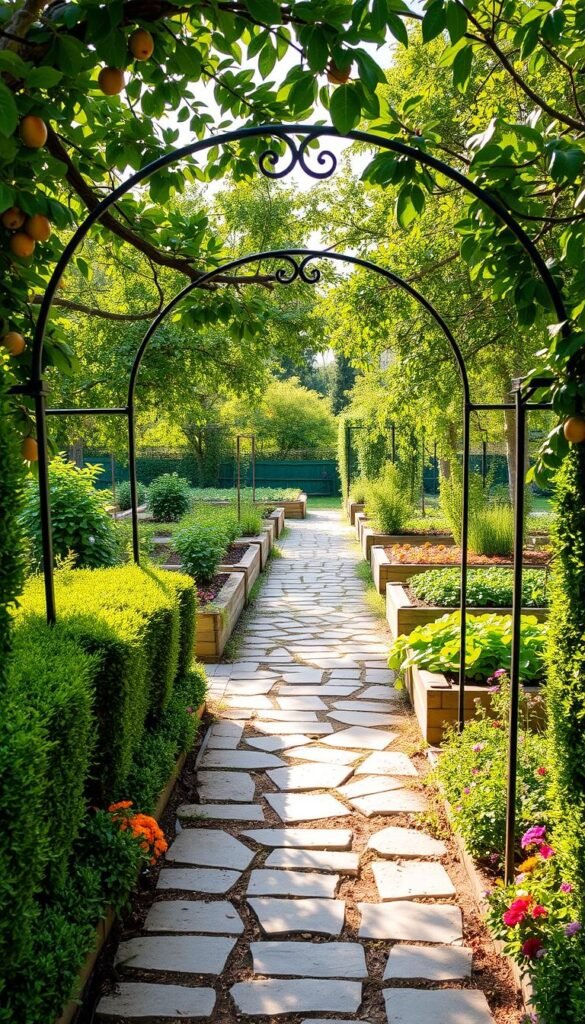
Which growing style matches your vision of a perfect harvest? Let’s tour five approaches that turn spatial limitations into creative opportunities. Each option serves different needs—from balcony-sized plots to sprawling food forests.
Space-Smart Solutions for Urban and Suburban Areas
Square-foot gardening revolutionizes small spaces with organized 4×4 grids. You’ll plant fast-growing radishes in one square while nurturing tomatoes in another. This method yields 4x more food per square foot than traditional rows.
For backyard gardens, blend raised beds with play areas. Place kid-friendly strawberries near seating zones, and tuck zucchini behind decorative trellises. You’ll maintain both aesthetics and productivity without sacrificing family space.
Scaling Up for Abundance and Beauty
Kitchen gardens shine near doorways with edible flowers mingling with herbs. Try alternating purple basil with calendula—their colors pop while repelling pests. You’ll snip ingredients for dinner without leaving your patio.
Homestead layouts demand efficiency. Plant corn in wide rows with walking paths every 15 feet. You’ll harvest bushels for preserving while keeping maintenance manageable. Pair these with fruit trees along property edges for layered food production.
| Layout Type | Space Needed | Key Benefit |
|---|---|---|
| Square-Foot | 4×4 ft+ | High yield in small areas |
| Raised Bed | Variable | Soil control & accessibility |
| Homestead | 1/4 acre+ | Food preservation quantities |
Your choice depends on available time and goals. Urban dwellers might combine vertical planters with mobile containers, while rural growers could mix rows with perennial berry patches. Every setup tells your unique food-growing story.
Optimizing Planting Techniques for Higher Yields
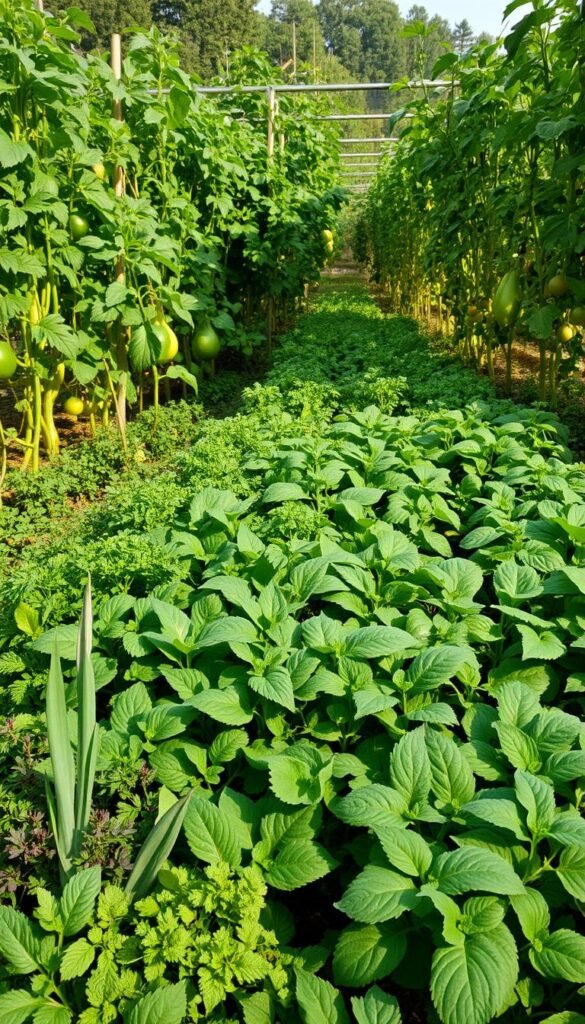
What if you could double your harvest without expanding your plot? Dense planting lets you squeeze more flavor from every square foot. Gardening expert Steven Biggs shares his secret: “Seed packets suggest commercial farm spacing—home growers can plant 30% tighter.”
Smart Spacing Strategies
Try scatter-seeding blocks instead of single-file rows. Broadcast carrot or spinach seeds across a bed, then thin clusters as they grow. You’ll harvest tender greens while making room for remaining plants to mature. This approach gives you two crops: microgreens now, full-sized veggies later.
Leafy greens thrive shoulder-to-shoulder, while root crops need breathing room. Use this quick guide:
| Plant Type | Spacing | Harvest Benefit |
|---|---|---|
| Lettuce | 4-6″ apart | Continuous leaf picking |
| Radishes | 2″ clusters | Baby roots + mature bulbs |
| Bush Beans | 6-8″ gaps | Airflow prevents mold |
Thinning becomes a harvest opportunity. Snip overcrowded beet greens for salads, leaving spaced plants to develop bulbs. For carrots, twist out every other seedling once they’re pencil-thick—you’ll get sweet fingerlings plus room for others to fatten.
Watch how plants interact. Kale might overshadow basil, but chives grow fine beneath tomatoes. Your garden becomes a living puzzle where smart spacing solves yield challenges. With practice, you’ll instinctively know when to thin aggressively or let plants compete.
Vertical Gardening: Making the Most of Your Height
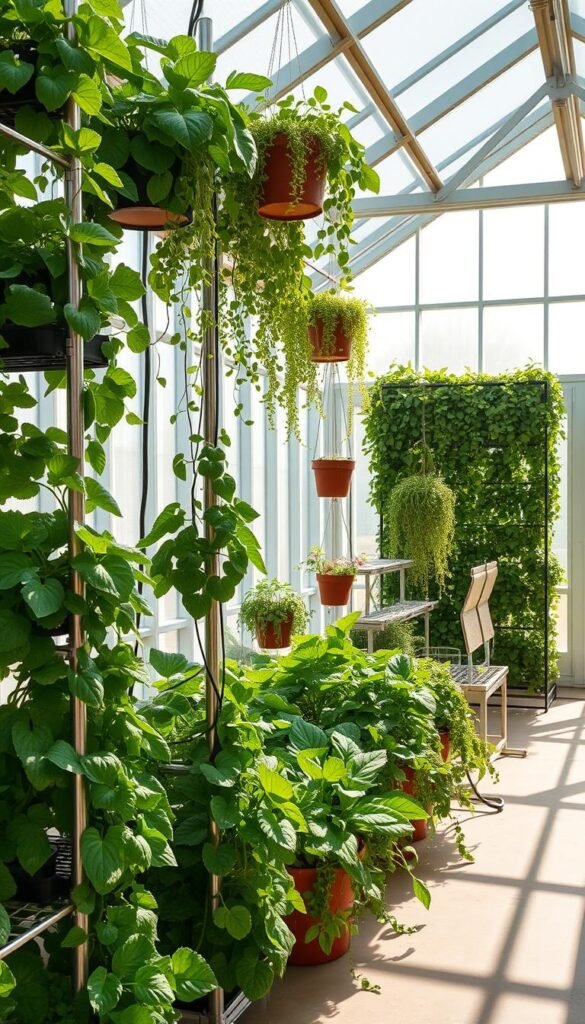
Have you considered looking up to grow more? Vertical systems let you harvest bushels of produce without expanding your footprint. By training plants to climb, you’ll free up precious ground space for root crops or seating areas.
Smart Support Structures for Heavy Yields
Steven Biggs’ bamboo A-frames prove simple solutions work best. Stretch wire mesh between poles to create sturdy scaffolds for cucumbers and squash. These DIY towers handle fruit weight better than flimsy store-bought trellises.
| Plant Type | Ideal Support | Yield Boost |
|---|---|---|
| Pole Beans | 6-ft Bamboo Tripod | 2x More Pods |
| Cucumbers | A-Frame + Mesh | 40% Space Saved |
| Malabar Spinach | Vertical Netting | Continuous Harvest |
Top Performers for Tight Quarters
Choose climbers that pack flavor into compact forms. Achocha vines produce cucumber-like fruits on 10-ft runners—perfect for covering fences. Try these space-stretching stars:
- Vining peas: Sweet snaps in 18″ width
- Runner beans: Scarlet blooms + edible pods
- Mini squash: ‘Eight Ball’ variety stays manageable
Hang baskets of thyme and lettuce below your structures. They’ll thrive in the dappled shade while you reach up to pick beans. This layered approach turns small spaces into 3D food factories!
Companion Planting: Maximizing Space with Strategic Crop Pairings
Did you know your radishes could babysit your carrots? This clever partnership shows how timing different growth rates unlocks hidden potential in your beds. By pairing quick and slow growers, you’ll harvest multiple crops from the same patch while improving soil health.
“When I scatter carrot seeds, I mix in radish seeds too. The radishes shoot up fast, marking rows and loosening soil. By harvest time, the carrots get all the space they need.”
Speed Dating for Plants
Fast-growing companions act as placeholders and natural tillers. Try these proven pairs:
| Quick Starter | Slow Grower | Bonus Benefit |
|---|---|---|
| Radishes | Carrots | Aerates soil |
| Spinach | Tomatoes | Shades roots |
| Bush Beans | Corn | Adds nitrogen |
These partnerships do triple duty. They suppress weeds early, deter pests with mixed scents, and maximize yield. After pulling radishes, carrot roots expand into the vacated space effortlessly.
Time your plantings like a symphony conductor. Sow quick-germinating seeds 2 weeks before main crops. As slower plants mature, their leafy canopies will shade soil exactly when summer heat intensifies.
Modern companion planting relies on science, not folklore. University studies confirm marigolds repel nematodes, while basil improves tomato flavor. Stick with these researched pairs for guaranteed results.
Efficient Pathway Design: Enhancing Access Without Sacrificing Space
Think pathways are just for walking? They’re actually your secret weapon for growing more food. Smart navigation routes let you tend plants easily while keeping every inch productive. Steven Biggs’ dead-end approach works like magic—create short access points that dive into beds without cutting them in half.
Walking Smart, Growing More
Angela Judd’s three-foot rule strikes the perfect balance. This width lets wheelbarrows glide through while leaving room for lush plantings. Try keyhole shapes where a single path serves multiple beds—you’ll reach the center of circular plantings without wasting precious growing area.
Materials matter as much as design. Mulched walkways suppress weeds naturally, while gravel drains well in rainy zones. For permanent solutions, flagstone pieces create a charming mosaic that lasts decades.
Your layout should make harvesting joyful. Curved paths feel spacious yet use less space than straight lines. Remember: narrow dead-ends near tomatoes mean more room for basil. Every step becomes purposeful when your garden flows smoothly from bed to basket.
